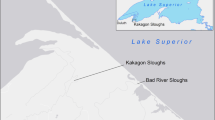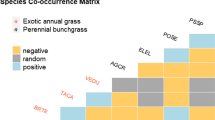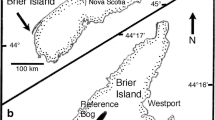Abstract
The vegetation of the 80.7 hectare Cowles Bog Wetland. Complex has been altered from its historic mixed sedge-grass domination (Carex stricta,Calamagrostis canadensis) in lower areas and woody growth in slightly elevated areas, as based on archival aerial photographs from 1938–1982 and recent field data. Cattails (Typha spp.) were present in 1938 and made minor gains in cover through 1970. However, the major invasion of cattails appears to be associated with stabilized, increased water levels caused by seepage from diked ponds constructed upgradient from the wetland in the early 1970s. The water level increases are assumed to have been of a magnitude which adversely affected the sedge-grass community but did not preclude cattail growth. The cattail vegetation type increased in cover from 2.0 ha in 1938 to 9.7 ha in 1970 to 37.5 ha in 1982. The sedge-grass vegetation type correspondingly decreased from 56.4 ha to 43.0 ha to 5.7 ha. Cattail invasion appears to have occurred through establishment of disjunct colonies by seed reproduction, followed by vegetative expansion and merging of the colonies.
Similar content being viewed by others
Literature Cited
Bernard, J. M. and M. L. Fitz. 1979. Seasonal changes in above ground primary production and nutrient contents in a central New YorkTypha glauca ecosystem. Bull. Torr. Bot. Club106: 37–40.
Beule, J. D. 1979. Control and management of cattails in southeastern Wisconsin wetlands. Tech. Bull. No. 112, Dept. Natural Resources, Madison, Wisconsin. 39 pp.
Carter, V., M. S. Bedinger, R. P. Novitzki, and W. O. Wilen. 1979. Water resources in wetlands. pp. 344–376.In: P. E. Greeson, J. R. Clark, and J. E. Clark. (eds.). Wetland Functions and Values: The State of Our Understanding. Amer. Water Resources Assoc. Minneapolis, MN.
Cressey, G. B. 1928. The Indiana Sand Dunes and Shore Lines of the Lake Michigan Basin. University of Chicago Press, for the Geographic Society of Chicago. 80 pp.
Deam, C. C. 1932. Trees of Indiana. Indiana Dept. of Conservation Publ. No. 13, first revision. Indianapolis, Indiana. 326 pp.
Farney, R. A. and T. A. Bookhout. 1982. Vegetation changes in a Lake Erie marsh (Winous Point, Ottawa County, Ohio) during high water years. Ohio J. Science82: 103–107.
Gillies, D. C. and W. W. Lapham. 1980. Reassessment of the effects of construction dewatering on ground water levels in the Cowles Unit, Indiana Dunes National Lakeshore, Indiana. Supplement to Geological Survey Water-Resources Investigations 78-138. U. S. Geological Survey Open-File Report 80-1105. 50 pp.
Gosselink, J. G. and R. E. Turner. 1978. The role of hydrology in freshwater wetland ecosystems. pp. 63–78.In: R. E. Good, D. F. Whigham and R. L. Simpson (eds.). Freshwater Wetlands — Ecologic Processes and Management Potential. Academic Press.
Grace, J. B. and R. G. Wetzel. 1981. Phenotypic and genotypic components of growth and reproduction inTypha latifolia: experimental studies in marshes of differing successional maturity. Ecology62: 789–801.
Grace, J. B. and R. G. Wetzel. 1982. Niche differentiation between two rhizomatous plant species:Typha latifolia andTypha angustifolia. Can. J. Bot.60: 46–57.
Harris, S. W. and W. H. Marshall. 1963. Ecology of water-level manipulations on a northern marsh. Ecology44: 331–343.
Henderson, N. R. 1982. A comparison of stand dynamics and fire history in two black oak woodlands in northwestern Indiana. M. S. Thesis, Utah State Univ., Logan, Utah. 52 pp.
Hendrickson, W. H. and D. A. Wilcox, 1979. Relationships between some physical properties and the vegetation found in Cowles Bog National Natural Landmark, Indiana. Proc. Sec. Conf. Sci. Res. Nat. Parks.5: 642–666.
Kadlec, J. A. 1962. Effects of a drawdown on a waterfowl impoundment. Ecology43: 267–281.
Kurz, H. 1923. Hydrogen ion concentration in relation to ecological factors. Bot. Gaz.76: 1–29.
Kurz, H. 1928. Influence ofSphagnum and other mosses on bog reactions. Ecology9: 56–59.
Kusler, J. A. 1983. Our National Wetland Heritage — A Protection Guidebook. Environmental Law Institute, Washington, D.C. 167 pp.
Linde, A. F., T. Janisch and D. Smith. 1976. Cattail — the significance of its growth, phenology and carbohydrate storage to its control and management. Tech. Bull. No. 94. Dept. Natural Resources, Madison, Wisconsin. 28 pp.
McNaughton, S. J. 1966. Ecotype function in theTypha community type. Ecol. Monogr.36: 297–325.
Meyer, W. and P. Tucci. 1978. Effects of seepage from fly-ash settling ponds and construction dewatering on ground-water levels in the Cowles Unit, Indiana Dunes National Lakeshore, Indiana. U. S. Geological Survey Water-Resources Investigations 78–138. 95 pp.
Millar, J. B. 1973. Vegetation changes in shallow marsh wetlands under improving moisture regime. Can. J. Bot.51: 1443–1457.
Pepoon, H. S. 1927. An Annotated Flora of the Chicago Area. Chicago Academy of Sciences. 554 pp.
Reshkin, M. 1981. Geology and soils of the Indiana Dunes National Lakeshore. Ecosystem study of the Indiana Dunes National Lakeshore, vol. one. INDU Research Program Report 81-01. 144 pp.
Rumberg, C. B. and W. A. Sawyer. 1965. Response of wet-meadow vegetation to length and depth of surface water from wild-flood irrigation. Agron. J.57: 245–247.
Sharma, K. P. and B. Gopal. 1978. Seed germination and occurrence of seedlings ofTypha species in nature. Aquatic Bot.4: 353–358.
Sjoberg, K. and K. Danell. 1983. Effects of permanant flooding onCarex-Equisetum wetlands in northern Sweden. Aquatic Bot.15: 275–286.
Smith, L. M. and J. A. Kadlec. 1983. Seed banks and their role during drawdown of a North American marsh. J. App. Ecol.20: 673–684.
Swink, F. and G. Wilhelm. 1979. Plants of the Chicago Region. The Morton Arboretum, Lisle, Illinois. 922 pp.
Tansley, A. G. 1913. International Phytogeographic Excursion (I. P. E.) in America, 1913. New Phytol.12: 322–336.
Walker, B. H. and R. T. Coupland. 1968. An analysis of vegetation-environment relationships in Saskatchewan sloughs. Can. J. Bot.46: 509–522.
Weller, M. W. 1978. Management of freshwater marshes for wild-life. pp. 267–284.In: R. E. Good, D. F. Whigham and R. L. Simpson (eds.) Freshwater Wetlands — Ecological Processes and Management Potential. Academic Press.
Weller, M. W. 1981. Freshwater Marshes, Ecology and Wildlife Management. Univ. of Minnesota Press, Minneapolis, 146 pp.
Weller, M. W. and L. H. Fredrickson. 1974. Avian ecology of a managed glacial marsh. The Living Bird.12: 269–291.
Wilcox, D. A. 1982. The effects of deicing salts on water chemistry and vegetation in Pinhook Bog, Indiana. Ph.D. dissertation. Purdue University, W. Lafayette, Indiana 139 pp.
Wilhelm, G. S. 1980. Report on the special vegetation of the Indiana Dunes National Lakeshore. INDU Research Program Report 80-01. 262 pp.
Author information
Authors and Affiliations
Rights and permissions
About this article
Cite this article
Wilcox, D.A., Apfelbaum, S.I. & Hiebert, R.D. Cattail invasion of sedge meadows following hydrologic disturbance in the Cowles Bog Wetland Complex, Indiana Dunes National Lakeshore. Wetlands 4, 115–128 (1984). https://doi.org/10.1007/BF03160491
Issue Date:
DOI: https://doi.org/10.1007/BF03160491




